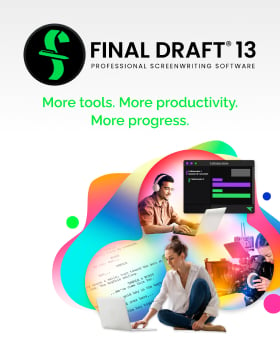Lessons for Screenwriters from CinemaCon 2025
April 9, 2025
Since 2011, CinemaCon has transformed Las Vegas into the movie industry’s ultimate insider gathering each year, drawing studios, stars, and distributors for a glimpse at Hollywood’s coming attractions.
The event is the official convention of the Cinema United, formerly The National Association of Theatre Owners. Obviously, the organization is focused on getting people into theaters to watch movies on the big screen. Hey, that’s my preference, too.
Think of it as a massive trade show where industry players reveal their cards for the months ahead. While there are plenty of celebrities plugging their latest and big trailer premieres, screenwriters should pay attention to what’s happening amidst the glitz. There’s value in understanding which genres and stories are actually (hopefully) selling tickets. Smart writers can take these insights to position their work in Hollywood.
So here are some of the key lessons we noticed this year.
Keep the Pulse of Industry Trends
For both new screenwriters or established pros looking to stay relevant, CinemaCon can be a window into what studios are buying and audiences are watching.
At this year’s event, we saw upcoming slates from Sony, Warner Bros. Pictures, Disney, Amazon/MGM, Lionsgate, Paramount, Universal Pictures, and more. These presentations reveal current trends that impact what types of scripts are most likely to get produced.
We’ve talked about these trends you should know already, but there is plenty to parse from what’s about to come out, what theater owners hope excites audiences, and what producers want to pick up.
Obviously, you want to write what you want to see, too. And you don’t want to write what everyone else is writing, not without giving a script your unique perspective or a fresh twist. But one way to stand out as a writer is to be savvy about the industry—know the big names, know what’s trending, and figure out where you fit in.
Which brings us to…
Genre is Still King
Despite all the constant industry evolution, it looks like genre is king. This year’s event had a heavy lineup of horror, action, sci-fi, superheroes, and more.
We do have to acknowledge that at the same time, genre remains closely caught up in intellectual property for most of the major studios’ slates. These teams are relying on what has worked in the past and what they hope will continue to bring in eyeballs. That means a Final Destination sequel, Megan 2.0, another Tron movie, a remake of The Running Man from Edgar Wright, as well as sure-fire hits in the second Wicked film and the final Mission: Impossible. We could go on.
But there are a few OGs peeking out from all this, too. Want a new heist film? Darren Aronofsky’s Caught Stealing had footage premiere at the con. And speaking of fresh takes on old stories, we can look at Maggie Gyllenhaal’s The Bride, where Jessie Buckley and Christian Bale star as the Bride and Frankenstein’s monster in her reimagining of the classic horror story.
Okay, so where does that leave us? I think the fact that genre is still popular gives writers plenty of room to play. We should understand genre while finding innovative ways to subvert or refresh the tropes we all know.
Comedy has a Comeback
We also need to mention that theatrical comedy has been showing signs of a comeback after years of struggling at the box office.
At CinemaCon, Paramount shared its first trailer for its upcoming The Naked Gun reboot, starring Liam Neeson as the son of the character originally portrayed by Leslie Nielsen. We also saw Derek Cianfrance’s Roofman, more of a crime story in which Channing Tatum plays a clumsy thief.
Writers with comedy scripts should take heart that the genre is coming back to big screens when, over the past few years, it’s largely been relegated to streamers. So keep punching up those jokes.
The Return of Mid-Budget Films
A renewed interest in mid-budget films ($20-40 million) represents one of the most significant opportunities for screenwriters today. After the industry had a big split between micro-budget indies and tentpoles for the last few years, some studios have been reconsidering the value of character-driven stories with modest price tags.
At CinemaCon this year, Angel Studios touted the value of the mid-budget film, pointing to its successes over the past two years.
The studio isn’t the only place looking for these projects. NEON also champions smaller indie films, sometimes all the way to big wins at the Academy Awards. While the company presented only a couple of projects at CinemaCon, it did so within the framework of audiences wanting more than just tentpoles.
Mid-budget filmmaking is where original stories and distinctive voices can find a home, especially for up-and-comers. So as you’re writing, you might consider what budget your screenplay falls under, and where you can take it for distribution.
A “Bingeable Moment in Cinema”?
Theatrical release strategies tend to dominate many CinemaCon conversations, with exhibitors and studios discussing approaches to bring audiences back to theaters. It’s been a struggle since the COVID-19 pandemic, as we all know.
At this year’s event, head of the Cinema United trade organization Michael O’Leary pushed for a 45-day theatrical window, according to The Los Angeles Times. Right now, those windows are much tighter, sometimes around two weeks, before films move to VOD or streaming. Again, this is all just beneficial for writers to know as educated members of the industry.
Interestingly, when Sam Mendes presented the cast for his quartet of Beatles movies at CinemaCon, he also revealed all four films would come out at once, in April 2028 (via Deadline). Sony and Mendes are calling it the first “bingeable moment in cinema,” so maybe streaming and theatrical are about to cross over even more.
The Power in Memes
Okay, so screenwriters aren’t in marketing, but to some degree we do need to know how to sell our stories, whether it’s in a pitch or to audiences. One thing I like to do is imagine what a trailer for my work would look like. Is it easy to imagine? Would people be excited to watch my movie? That’s probably a good sign.
But successful recent releases share another common element: memorable, shareable moments that have legs on social media. We’re thinking of Megan 2.0 from this year’s CinemaCon, which is already capitalizing on its ridiculous robot hijinks.
Please don’t write scenes or lines you think will go viral, because that almost never works. But this can be a good reminder to go big—make your characters large enough that they leap off the page and say things in a way only they could. Then you might organically arrive at the Terminator’s “I’ll be back,” or Megan’s iconic dance of death.
If screenwriters only take one lesson from CinemaCon this year, it’s this – there are lots of opportunities still available to screenwriters on the theatrical front, and plenty to be excited about in the year ahead.
Written by: Jo Light
A recovering Hollywood script reader, Jo spent several years in story development, analyzing screenplays for the likes of Relativity Media and ICM Partners while chasing her own creative dreams. These days, she juggles writing for industry leaders Final Draft, ScreenCraft, and No Film School, teaching budding writers at the college level, and crafting her own screenplays—all while trying not to critique every movie she watches.





